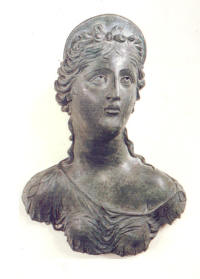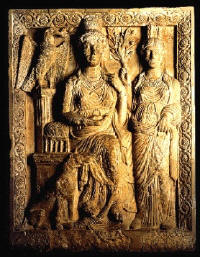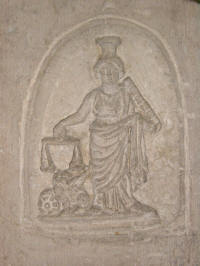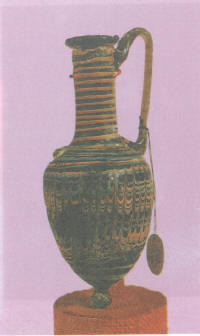First Gallery
The showcases of this gallery are devoted almost entirely
to the marble , bronze and ivory statues . Some marble and limestone
sculptures are also displayed between the showcases .
|

Bronze bust representing (princess ?). She is
beautiful and her features express deep meditation. Her hair is wavy,
plaited and gathered at the back. Her silk robe reveals a slight part of
her left shoulder. A circular frame in bronze surrounds the bust. |

An ivory curving.
|
|
Second Gallery
The showcases of this gallery are designed for pottery
and glassware . they also show the development of these two industries.
Some basalt sculptures are also displayed .
Terracotta figurine depiction Nemesis, the goddess of
justice and vengeance. She wears a long robe and a head-dress. She
carries scales, symbol of justice , in her right hand and a wheel,
symbol of her changing nature , in her left hand .
H. 28 cm. |
 |
The Phoenician Glassware:
Some scholars hold that the origin of glass was in Syria. There is the
often quoted story of the Phoenician Sailors and their chance discovery
of glass through the combination of fire, sand from the sea-shore and
snatronoda from their cargo of natron which let the appearance of a
transparent liquid, known later as "glass".
The term "Phoenician glass" has been given to flasks of opaque glass
resembling the Greek marble blasamariurn. The method of manufacturing
these flasks is as follows:
They bring a metal rod and fix clay and sand round it. Then they plunge
it in an adhesive glass paste. After the rod is drawn out of the paste,
a thread of soft glass is wound round it until sufficient glass has been
gathered to form the required shape of the vessel. The glass is then
retreated and rolled on a marble slab to smooth and polish it. Forms of
decoration such as the trailing of colored lines of glass, are applied,
and further marveling and light raking with a comb treat the typical
feathered decoration. Handles and foot-stands are added later with
tongs. Finally, the rod is removed and the vessel is left to dry. It is
interesting to note that they continued to use this method from the 14th
century down to the first centuryB.C. When the Greek marble basamariums
appeared, the glass-workers were struck by their beauty and began to
imitate the style of their decoration. i.e. coloured branches and
garlands.
The national Museum of Damascus is considered one of the riches Museums
of the world in its collection of glassware. Most of the Museums of the
world, however, do have important collections of the Syrian glassware.
History has also preserved to us the names of a number of glass-makers
such as Ennion or Artas etc. and this suggests the extent to which the
glass industry in Syria flourished.
 |
|
|